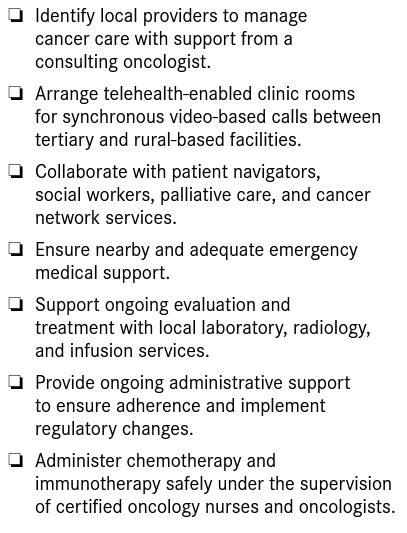Publication
Article
Practice Recommendations Make Room for Telemedicine in Oncology Care
Author(s):
Telemedicine solidified its role as a new standard in patient care during the COVID-19 pandemic.

Telemedicine solidified its role as a new standard in patient care during the COVID-19 pandemic. The American Society of Clinical Oncology (ASCO) has issued standards and guidance pertaining to its use for patients receiving oncology-specific care and to the roles of various providers who may interact with patients over their course of treatment.1
Though not a novel concept, telemedicine in medical practice has struggled to see widespread use in practices. Pivoting to meet the demands of maintaining uninterrupted, ongoing care while in-person visits were restricted, organizations including ASCO issued interim policies and guidelines at the academic and community practice level.2 ASCO adopts the language defined in the New England Journal of Medicine Catalyst to refer to telemedicine as that which “encompasses the use of technologies and telecommunication systems to administer health care to patients who are geographically separated from providers.”2
A multidisciplinary panel of expert health care providers, a patient representative, and a health research methodologist contributed to the creation and review of the ASCO Standards and Practice Recommendations on telemedicine in oncology. The participants conducted a systematic review of the available literature concerning different methods of telehealth delivery in oncology as well as oncology-specific standards previously issued on related topics.1
For Which Patients Is Telemedicine Care Appropriate?
Investigators determined the specific patient populations for whom telemedicine may be an appropriate option when in-person visits are not possible. They considered whether outcomes for patients differed between those who received in-person care vs those who had telemedicine visits. Several categories were identified as appropriate for standard or long-term treatment telemedicine visits (Figure 11).
Figure 1. Patient Selection and Implementation of Telemedicine in Oncology Care1

In-person visits preferred by the care provider included those for initial consultations, initial delivery of antineoplastic treatments, and delivery of key information regarding a patient’s treatment plan. For example, an in-person visit would be better for relaying the complex cancer treatment needs and information concerning disease progression; it would also be more suitable for physical examinations required during follow-up visits. However, the investigators noted that telemedicine may be used if local care providers are able to perform physical examinations and consult with the primary treatment team via referral communication.
The physician-patient relationship, specifically concerning initial meetings with the care team, should include an in-person visit at the primary care location. Follow-up visits and other responsibilities consistent with community standards should mandatorily be executed via telemedicine following the initial visit.1 As pandemic-related policies ease, the expansion of services covered as telemedicine services by the Centers for Medicare & Medicaid Services (CMS) has already been implemented when CMS permanently expanded coverage in December 2020.3,4
The 2022 proposal for coverage looks to maintain this expanded coverage through December 21, 2023, to provide evidence for the review of services that should be permanently added to the coverage.5
Oncology-Specific Workflow Implementation Considerations
Safety and quality of care are the foremost concerns in the adoption of telemedicine services. Objective monitoring and timely reporting of patient outcomes, physical examinations, and laboratory tests, are essential to providing the highest quality of continued care. Data including rates of emergency department visits, adverse effects, and hospitalizations are also vital.1,6
The ASCO standards highlight that those operating procedures for interventions that are delivered asynchronously (ie, patient symptom reporting) should outline appropriate and timely responses to patient-reported outcomes.1
For example, adequate documentation for each telemedicine visit should confirm the patient’s agreement to partake in a telemedicine visit, the date of the visit, location of the visit for both patient and provider, participants, and what technology was used (ie, audio only, videoconferencing, etc).1
Although technology certification is not required, both patients and providers should receive orientation on the platform and instructions should be delivered to the patient if the provider needs to assess an area of the body. The authors note that a technology support individual should be present for clinical visits to troubleshoot any issues.
Additionally, to enhance the efficiency of telemedicine as it relates to patient adherence to prescribed treatments, practices should implement automated reminders tailored to the individual patient. These reminders should consider the health and technological literacy.
Recommended steps for practices for sustaining telemedicine oncology program are outlined in FIGURE 2.1
Figure 2. Sustaining a Telehealth Oncology Program1

Following a review of the clinical practice guidelines for teleoncology issued by the Clinical Oncology Society of Australia, ASCO’s expert panel endorsed the recommendations pertaining to the role of allied health professionals in telehealth interventions. Specifically, telephone-based evaluations can help to facilitate changed behaviors, improved function, and improved psychologic or psychosocial status; computerized screening or assessment may be used to collect information on patient status and assist with referral to allied health oncology services; hybrid telehealth systems may be used as alternative models of care; and videoconferencing may be used to deliver health assessments and treatment services from allied health professionals to oncology patients.1,7
For more detailed information on process, the expert panel endorses the American Medical Association’s Telehealth Implementation Playbook, which outlines the process of making telemedicine an integral part of a practice from identifying a need through evaluating success.8
Limits of Telemedicine
In addition to its potential to expand access for many patients, telemedicine’s limitations are also addressed in the standards. Care via telemedicine consultations has been determined as being appropriate for some populations; however, the investigators noted that patients with hearing loss, vision loss, or cognitive limitations who have no alternative support systems to assist them with telemedicine visits should continue with in-person visits.1
Additionally, patients without access to technology (ie, broadband internet or devices to host the visit) and those with limited health literacy should also seek in-person care. “Within many studies, telehealth is cited as a way of reducing costs for patients by eliminating travel and associated fuel and lodging charges and minimizing the time away from paid work,” the authors of the ASCO standards wrote in the discussion. “However, for patients who do not have access to sufficient broadband to participate in a videoconference or do not have a mobile phone, inequity of access will continue and may be exacerbated.”
The authors noted that, “when possible, patients may be given the option of in-person or telemedicine visits, according to personal preference.”1
Future Applications in Clinical Trials
To increase recruitment for clinical trials, the ASCO standards recommend that virtual participation be offered, where feasible, as it reduces the burden of trial participation on patients.1
“Many clinical practice guidelines, including those produced by ASCO, call for inclusion of patients in clinical trials whenever possible,” the authors wrote. “However, many patients, such as those who live outside of urban centers, face barriers to access, and fewer than 10% of patients with cancer in the United States are enrolled in clinical trials.”
The recommendations from ASCO include using virtual services for initial discussions of trial information as well as assessment of eligibility; remote monitoring of symptoms and adverse effects; remote initiation of treatment conducted through sponsors or contract research organizations; shipping oral anticancer agents directly to patients when applicable with a follow-up call to review dosage schedules; permitting local laboratory testing for blood and biopsy samples; reviewing the necessity of testing frequency in trial protocols; and increasing the use of patient-reported outcomes as study end points.1
“Changes [implemented during the COVID-19 pandemic] may have a lasting impact on clinical trials and result in improved access and participation over the long term for remote or less-mobile patients,” the authors wrote.
References
- Zon RT, Kennedy EB, Adelson K, et al. Telehealth in oncology: ASCO standards and practice recommendations. JCO Oncol Pract. 2021;17(9):546-564. doi:10.1200/ OP.21.00438
- ASCO interim position statement: telemedicine in cancer care. ASCO. Accessed October 11, 2021. https://www. asco.org/sites/new-www.asco.org/files/content-files/ advocacy-and-policy/documents/2020-ASCO-Interim-Position-Statement-Telemedicine-FINAL.pdf
- Trump administration finalizes permanent expansion of Medicare telehealth services and improved payment for time doctors spend with patients. News release. CMS. December 1, 2020. Accessed October 11, 2021. https:// go.cms.gov/3r9n8xt
- List of telehealth services. CMS. Updated August 17, 2021. Accessed October 11, 2021. http://go.cms.gov/3sJv4FT
- Calendar year (CY) 2022 Medicare physician fee schedule proposed rule. CMS. July 13, 2021. Accessed October 12, 2021. https://go.cms.gov/2XaDz2U
- Royce TJ, Sanoff HK, Rewari A. Telemedicine for cancer care in the time of COVID-19. JAMA Oncol. 2020;6(11):16981699. doi:10.1001/jamaoncol.2020.2684
- COSA Teleoncology Guidelines Working Group. Clinical practice guidelines for teleoncology. Cancer Council Australia. Updated May 20, 2021. Accessed October 12, 2021. https://wiki.cancer.org.au/australiawiki/index. php?oldid=215348
- Telehealth Implementation Playbook. American Medical Association. 2020. Accessed October 12, 2021. https:// www.ama-assn.org/system/files/2020-04/ama-telehealth-playbook.pdf










